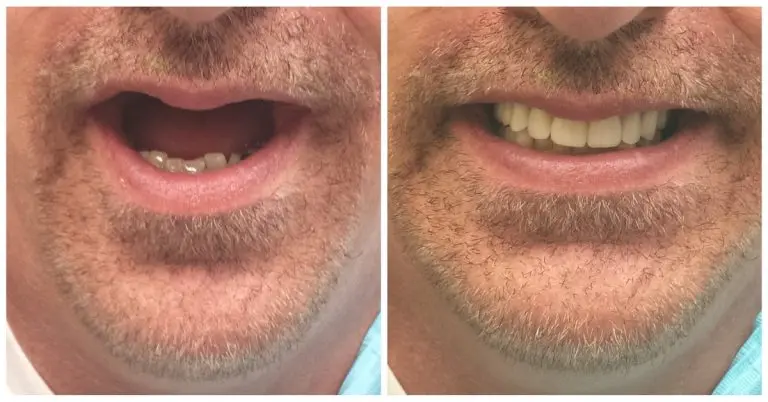Full Mouth Rehabilitation
Full mouth rehabilitation, also known as full mouth reconstruction, is a comprehensive form of dental treatment. It involves reconstructing or rebuilding all of the teeth in both the upper and lower jaws. Full mouth rehabilitation typically combines aesthetics with the science of restorative dentistry to improve the health, function, and beauty of the mouth. This extensive procedure is usually recommended for those who have severe dental issues.
Reasons
Wearing of the teeth can be due to bruxism (teeth grinding) or acid erosion.
Missing teeth can impact the bite and overall oral functionality.
If numerous teeth with large fillings are failing or exhibiting decay, full mouth rehabilitation may be required.
Cracked or broken teeth due to trauma or decay.
Pain can sometimes be associated with bite problems and may required treatment.
Gallery
Visual insights to help you understand what to expect from your treatment. For more content, please refer to our Education Hub.

Benefits & Considerations
Everything you need to know to make an informed decision about your treatment.
Benefits
Improved Oral Function
Patients experience notable improvements in oral function through rehabilitation treatments. Procedures like dental implants, bite correction, and tooth repairs enhance chewing and speaking abilities, which in turn aids digestion and overall nutrition by ensuring food is properly chewed.
Increased Oral Health
The comprehensive approach of full mouth rehabilitation means tackling all potential sources of oral disease at once, which has a cascading effect on overall oral health. Procedures like scaling, root planing for gum disease, and cavity filling help prevent further decay or deterioration of the mouth’s health.
Aesthetic Improvement
Full mouth rehabilitation includes cosmetic procedures like veneers, crowns, and teeth whitening, enhancing the smile's appearance. These changes can significantly elevate self-esteem and provide a refreshed look.
Improved Jaw Health and Support
By correctly aligning the bite and replacing missing teeth, full mouth rehabilitation helps distribute bite forces evenly, reducing stress on the jaw. This can alleviate symptoms of TMJ disorders, such as jaw pain and headaches, and prevents further wear on teeth.
Long-Term Durability and Protection
Using advanced materials and modern dental techniques, rehabilitations provide durable results that can last many years with proper care. Protective measures integrated within treatments, like crowns over weakened teeth, help guard against future damage or decay.
Comprehensive and Customised Treatment
One of the key advantages is the customized nature of the treatment. Every aspect of the patient's oral health is considered to create a tailored treatment plan that addresses all issues comprehensively, instead of tackling one problem at a time.
Psychological and Social Benefits
With the restoration of a functional and attractive smile, patients often experience a significant boost in confidence and self-image. These psychological benefits can lead to enhanced social interactions and openness in personal and professional environments.
Enhanced Comfort
Full mouth restoration also alleviates discomfort or pain associated with dental problems. By addressing multiple issues like decay, damage, bite discrepancies, or gum disease, the treatment reduces sensitivity, pain, and discomfort in daily activities including eating and speaking.
Considerations
Infection Control
All surgical procedures, such as dental implants and gum surgery, involve a risk of infection. Our team adheres to strict sterilisation and hygiene protocols to ensure safety. We also provide comprehensive post-operative care instructions to help you maintain optimal oral hygiene and reduce the risk of infections.
Implant Placement
For upper jaw implants, our experts utilize 3D cone beam CT scans for precise planning, reducing sinus complication risks. In the lower jaw, we carefully avoid the mandibular nerve using guided surgery techniques to ensure safety during the procedure.
Osseointegration
Implant failure can occur if it does not properly fuse with the jawbone, often due to factors like infection, low bone density, or excessive pressure. Our dental team assesses each patient's oral health and bone density to optimise outcomes. We also offer bone grafting to enhance bone availability for successful implant placement, increasing the likelihood of osseointegration.
Prosthesis Fitting
Problems like ill-fitting crowns, bridges, or dentures can cause discomfort and hinder chewing or speaking. Our skilled technicians in the in-house dental lab create custom restorations, ensuring a perfect fit and function. We use precise impressions and cutting-edge digital technology to produce durable and comfortable prosthetics.
Peri-implantitis Control
This condition involves inflammation of the tissues surrounding dental implants, akin to gum disease, which can lead to bone loss and implant failure. Our practice prioritises preventive care and utilises advanced implant materials that enhance bone growth and minimize infection risks, ensuring the longevity of your implants.
Prolonged Sensitivity
Following dental treatments, you may experience temporary sensitivity to hot and cold. This usually fades, but if it persists, we can suggest desensitising toothpastes or other solutions. Regular check-ups help us manage any ongoing sensitivity effectively.
Treatment Procedure
Let's walk through your treatment procedure from start to finish.
Comprehensive Examination
A thorough examination is conducted, including medical and dental history review, clinical examination, diagnostic radiographs (X-rays, 3D cone beam CT scans), extraoral and intraoral photography, and impressions or digital scans of the teeth and bite.
Treatment Planning & Digital Wax-Up Creation
Based on the evaluation, a comprehensive treatment plan is developed, outlining the necessary procedures, such as tooth extractions, bone grafting, implant placement, and various restorations (crowns, bridges, veneers, implants).
Within our practice, our skilled dental technician team is able to plan the implant placement with our specialised implant planning software for form, function, and aesthetics, whilst addressing all above considerations. A surgical guide is created in house to ensure the placement of the implant is correct with negligible error.
All other restorations are also designed within our software, and a full-mouth digital wax-up is created.
Temporisation
Temporary restorations, stents, or a temporary removable partial denture may be fabricated to maintain function and aesthetics during the treatment phase.
Implant Placement Surgery
On the day of the surgery, our skilled dentist begins by extracting any remaining teeth that need to be removed. Next, the dental implants are carefully placed into the jawbone, guided by a surgical guide created using advanced planning software. The gums are then sutured to allow for proper healing.
If the jawbone is not dense enough to support the implants, bone grafting might be needed. This procedure involves taking bone from another area of your body or using a synthetic material to augment the jawbone. Bone grafts require several months to heal.
Osseointegration
Complete healing and integration of the implant with the jawbone can take anywhere from a few weeks to several months. During this time, you may have temporary crowns installed to allow you to eat and speak normally without stressing the implant site. These restorations are also designed and manufactured in-house for optimal form and function.
A customised healing abutment may also be fabricated by our technician team to enforce shaping of the soft tissue (gums) around the future tooth for optimal aesthetics. Additionally, this abutment minimises the risk of bacteria entering the implant socket,
Abutment Placement
Once the implants have successfully integrated, abutments (connectors) are attached to the implants, protruding through the gums, to support the final restorations.
Impression & Records
Precise impressions or digital scans of the prepared teeth, implant abutments, and bite registration are taken to fabricate the final restorations.
Provisional Restorations
Temporary crowns, bridges, or veneers may be placed to evaluate fit, function, and aesthetics before fabricating the final restorations.
Final Restoration Fabrication
Based on the impressions or digital scans, the final restorations (crowns, bridges, veneers, implant-supported restorations, or dentures) are carefully designed and fabricated in the dental laboratory.
The restorations are manufactured in-house via state-of-the-art 3D printing or milling machinery. MODJAW technology may be utilised to ensure comfort and safety in performing dynamic jaw movements such as protrusion, lateral excursions, chewing, and speech.
Final Restoration Delivery
The final combination of restorations are meticulously adjusted, fitted, and cemented or screwed into place, ensuring proper occlusion (bite), function, and aesthetics.
Occlusal Adjustment
The bite is carefully evaluated and adjusted to ensure even distribution of forces and proper functional movements.
Maintenance & Follow-Up
Regular follow-up appointments are scheduled to monitor the restorations, assess the health of the surrounding tissues, and address any potential issues or necessary adjustments.
Post-Operative Care
Simple steps to protect your smile and ensure optimal results in the days following your procedure.
Rest & Recovery
Avoid strenuous activities for the first 24-48 hours to promote healing and minimize swelling. Apply cold compresses as instructed to reduce discomfort and swelling.
Oral Hygiene
Be gentle when brushing, avoid surgical sites initially. Use recommended saltwater or antiseptic rinses to keep the area clean. Avoid smoking during the recovery period.
Diet and Nutrition
Follow a soft or liquid diet as advised by your dentist. Gradually reintroduce solid foods as healing progresses. Stay hydrated but avoid very hot beverages and using straws.
Long-Term Care and Follow-Up
Attend all scheduled follow-up appointments for monitoring and addressing any complications early. Wear a night guard if recommended to protect your new dental work.
Suture Care
Bite down on gauze pads as instructed to control bleeding. Avoid disturbing any sutures with your tongue or food, and follow instructions for suture removal appointments.

Full mouth rehabilitation is a highly customized treatment plan designed to address severe dental problems that affect the entire mouth. It combines various dental disciplines to restore not only the functionality but also the aesthetic aspects of the teeth and gums. If you believe you might benefit from this comprehensive approach, discuss it with a qualified dentist who has experience in full mouth rehabilitation to explore your options.